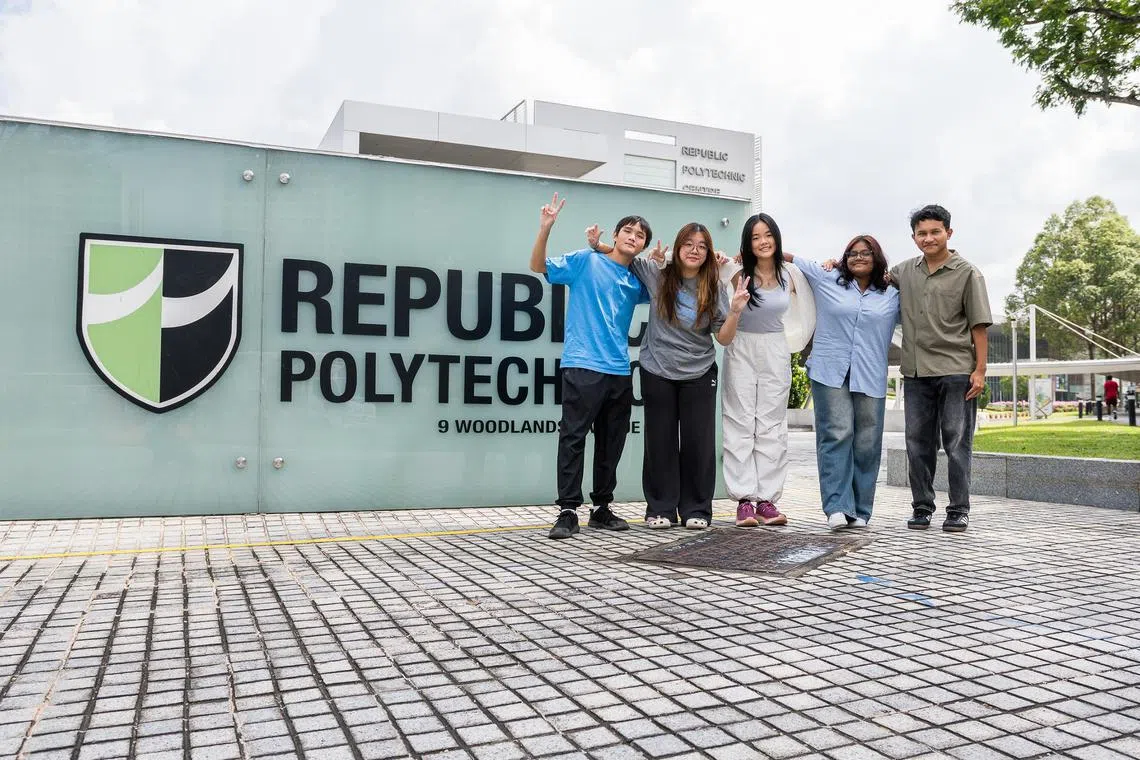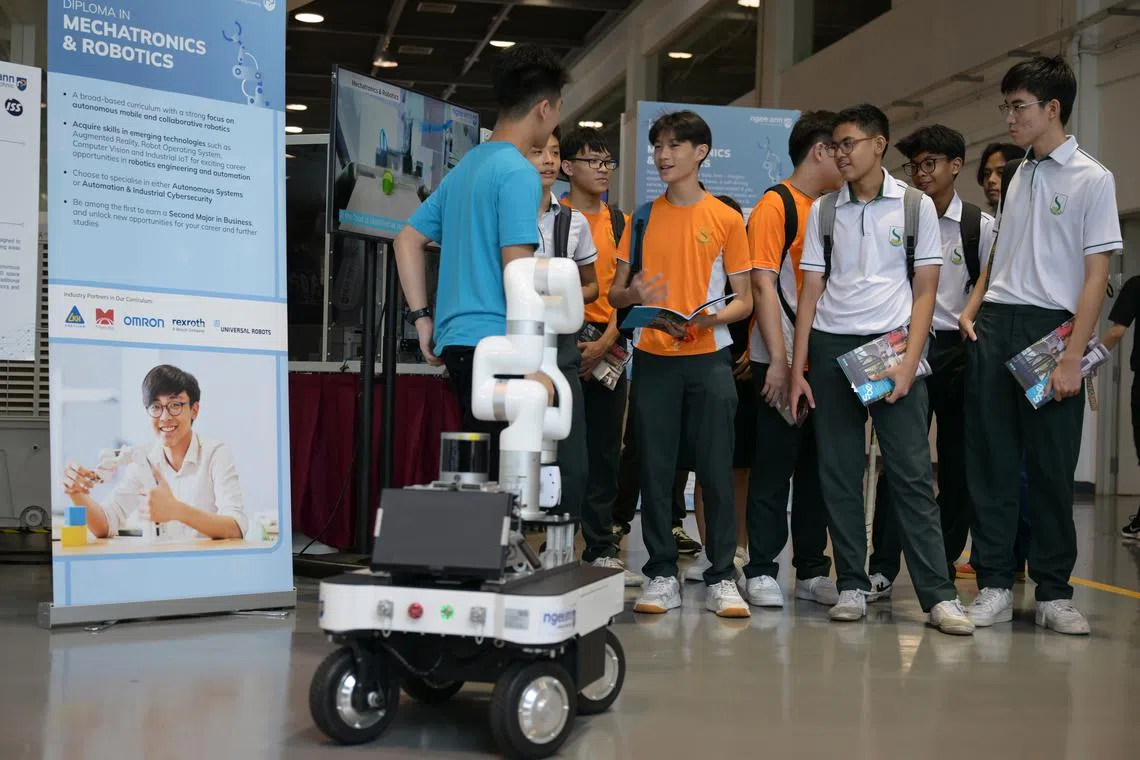From poly to uni: What you need to know
The TL;DR: To improve your chances of qualifying for university after graduating from a polytechnic, get a good grade point average and also showcase your non-academic attributes through co-curricular activities or portfolios.
Sign up now: Get ST's newsletters delivered to your inbox

Polytechnics have more hands-on, personalised learning and mentorship for their students.
PHOTO: NGEE ANN POLYTECHNIC
Follow topic:
Looking to snag a place in a local autonomous university? The figures are encouraging.
The six public universities took in 18,000 Singapore citizens and permanent residents in 2022. This translates to a 42 per cent cohort participation rate, which means more than four in 10 students from every cohort were given places in degree programmes funded by the Ministry of Education.
Recent statistics also show that four in five A-level and International Baccalaureate graduates enrol in the universities, while one in three polytechnic graduates matriculate at these institutions.
TL;DR spoke to the five polytechnics and six autonomous universities about what it takes to move from polytechnic to university.
Importantly, remember there’s no cap on the number of polytechnic students who can move on to the autonomous universities.
What proportion of students in the autonomous universities come from the polytechnics?
Nanyang Technological University (NTU): “Polytechnic graduates make up about a third of NTU’s yearly admission applications.” It did not give enrolment numbers.
National University of Singapore (NUS): It “welcomes applicants from diverse educational backgrounds”. It did not give enrolment numbers.
Singapore Management University (SMU): It “enrols many students from all five local polytechnics every year”. It did not give enrolment numbers.
Singapore Institute of Technology (SIT): Currently, nine in 10 students in its yearly intake come from the polytechnics.
Singapore University of Social Sciences (SUSS): About 80 per cent of the more than 1,000 full-time undergraduates in the 2024 academic year were fresh polytechnic graduates. Separately, the university also takes in part-time undergraduates who are working adults.
Singapore University of Technology and Design (SUTD): “Polytechnic applications have increased significantly and currently make up approximately 20 to 30 per cent of each cohort.” It said it admits between 500 and 550 students “with very diverse backgrounds and qualifications” per cohort.
I’m a polytechnic student who wants to go to university. How can I plan ahead?
Other than having a good grade point average, you would do well to demonstrate “holistic” qualities and “aptitude”, among other strengths.
NUS said that the university has expanded its holistic admission process, including introducing a range of special aptitude-based admissions schemes. Some of these that are applicable to polytechnic students are the Polytechnic Entrepreneurship Pathway nomination scheme, Social Work Pathway nomination scheme and, more recently, the Enhanced Aptitude-Based Admissions to NUS College nomination scheme.
SMU said that it looks for the evidence of “qualities such as aptitude, positive attitude, intellectual curiosity, critical thinking and communication skills” through leadership in co-curricular activities, impactful involvement in community services and volunteer programmes, entrepreneurship or “noteworthy involvement” in work or internships relevant to the course applied for. Other factors include significant awards and achievements in areas relevant to the course applied for.
With universities placing more emphasis on aptitude-based admissions and holistic assessments, some of the areas you should pay attention to include:
Interview skills
Depending on the school and course you apply to, you may be asked to attend an admissions interview.
Make sure you’re able to show some understanding of the programme you applied for and why you want to be part of it.
An SUSS spokesman advised candidates to show “thorough preparation and a clear enthusiasm for their chosen programme”.
Co-curricular activities
What you have done outside your academic studies can also give your application a boost, said Ms Lynette Ang, the director of admissions at SUTD.
“What activities they engage in tells us a lot about them as a person,” she explained.
This doesn’t mean that you need to be juggling dozens of co-curricular activities to prove your worth.
Professor Goh Say Song, the dean of admissions at NUS, said it is more important to focus on “the desired qualities and experiences that students demonstrate through their involvement in extracurricular activities”.
Portfolios (if applicable)

At SUSS, about 80 per cent of the more than 1,000 full-time undergraduates in the 2024 academic year are fresh polytechnic graduates.
ST PHOTO: GAVIN FOO
While you’re not required to show a portfolio of work, it could help in showing you’re well-rounded and highlighting your non-academic attributes.
Ideally, your portfolio should include co-curricular activities, community service, leadership roles, and work experiences or job-shadowing stints, said SUSS. “Portfolios provide a comprehensive view of students’ journey and non-academic accomplishments beyond their academic achievements.”
Said SUTD’s Ms Ang: “Portfolios are a good way to demonstrate how they have spent their time and energies outside the classroom. We encourage applicants to show us what they have done – art, videos, code, prototypes, essays... Helping us understand what they have gone through and learnt from the process is more important than the number of items or the size of the portfolio.”
Should I have one or more internships before applying to the autonomous universities after polytechnic?
While not expected or required, internships can help give the universities more information or context about you. The good news is, you’re likely to have already done at least one internship as part of your polytechnic course.
Ms Veronica Wong, SIT’s head of admissions and financial aid, said the institution gives “due credence” to relevant work or internship experiences as “an indicator of one’s aptitude, aspirations, and proficiency in the admissions review process”.
What are some programmes available in polytechnics that could help me holistically?
Polytechnics do have more hands-on, personalised learning and mentorship for their students.
For example, from 2025, under Republic Polytechnic’s Designing Your Life programme, incoming students will be guided by their lecturers who will use a Stanford-developed design-thinking approach to explore and plan their personal and career goals.
Ngee Ann Polytechnic in 2021 rolled out its Personalised Learning Pathway Minors programme, which allows its students to graduate with specialised minors on top of their diplomas. From 2025, it has expanded the number of available minors.
Nanyang Polytechnic recently launched its Living Lab project, inviting companies to work with its staff and students to develop and test new ideas on campus.

Under Republic Polytechnic’s Designing Your Life programme, incoming students will be guided by lecturers using a Stanford-developed design-thinking approach to explore and plan their personal and career goals.
PHOTO: REPUBLIC POLYTECHNIC
Temasek Polytechnic introduced the “use of adaptive learning platforms to track students’ progress” in real time, as part of personalised learning, said Mr Sng Choon Leng, its director of academic affairs. He said this “will better provide them with valuable vocational and life skills that open doors to a wide range of career and further study opportunities”.
Singapore Polytechnic partnered with Mentoring SG, a national-level office, to launch the first school-based Youth Mentoring Hub. This would give more than 10,000 of its students better access to mentors over the next three years to help them chart their career and life goals.
If I fail in my first application to a university after graduating from polytechnic, do I stand a chance if I apply again?
In short, yes, but it’s best if you can include new information in your application.
Said SUTD’s Ms Ang: “There are applicants who gain admission upon reapplying. It is important to provide us with new information that can present a stronger case – whether it’s academics, projects or skills. Persistence and growth are qualities that we admire. Repeat applicants need to be able to demonstrate what has changed significantly since their last application.”
SIT’s Ms Wong said: “Admissions are competitive, and showcasing growth or progress can make a significant difference in strengthening one’s relative standing in the next application.”
She added that this could include gaining relevant work or internship experience, or developing skills and competencies through supplementary courses, competitions and extracurricular activities.
NTU’s associate provost of undergraduate education, Professor Gan Chee Lip, said: “An applicant who is unsuccessful in his or her first choice of programme can try to improve their grades or showcase examples that highlight their aptitude.”
Alternatively, you may want to explore other related courses, he added.
Republic Polytechnic Career Centre said students could take the time before the next application to address the gaps in their previous application: “While waiting for the next intake application, it is essential for students to reflect on their previous application and, where possible, seek feedback to identify areas for improvement. Improving grades, building a more robust portfolio, or gaining relevant work or traineeship experiences, will help to increase their chances of success.”

Students learning about Ngee Ann Polytechnic’s diploma in mechatronics and robotics course at its open house on Jan 8.
PHOTO: ST FILE
Madam Wendy Lee, the lead education and career coach at Nanyang Polytechnic’s Centre for Student Support and International Relations, said: “Students who are unsuccessful in their university application should consider gaining meaningful experiences like working, volunteering or taking short courses to develop practical skills, to boost their chances for future university applications.”
She added that students could also seek feedback from the university to understand the reasons for their unsuccessful application and take the feedback into account for their future applications. “Alternatively, students can reassess their options and consider alternative pathways to achieve their academic and career goals.”
Ms Louisa Lau, the director of Ngee Ann Polytechnic’s Office of Immersion and Careers, suggested a number of options:
Join the workforce to gain relevant experience
Pursue a SkillsFuture Work-Study Post-Diploma, which combines employment with further learning and skills development
Enrol in part-time degree programmes offered by the autonomous universities
Build your portfolio through internships
Explore overseas universities where entry requirements may differ, while considering factors like financial resources and programme recognition by professional bodies
If you need more guidance, Singapore Polytechnic’s Department of Student Services also said that polytechnic graduates could explore their options with education and career coaches.
TL;DR covers stories for and about youth aged 17 to 23, to help you slay, serve and survive school and life like a boss. If you’re headed to or are in junior college or pre-university, polytechnic or ITE in 2025, look out for an e-mail on how you can keep up with all our coverage. Follow us on www.instagram.com/st.tldr
Ang Yiying is a correspondent with The Straits Times, covering news related to young people.


